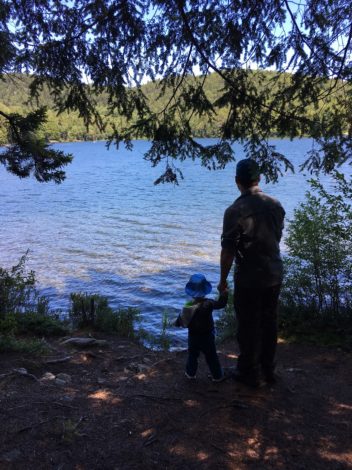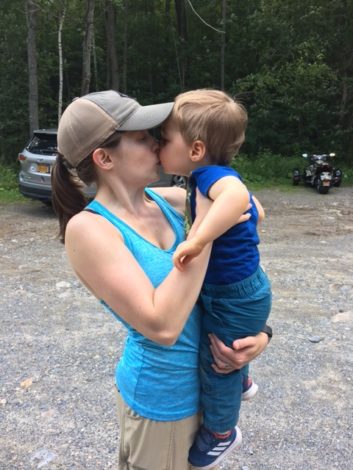How Nature Mends the Heart When Coping with a Miscarriage
Editor's Note: This article discusses specific details of a miscarriage and may be triggering for some readers.
In December 2016, my husband and I discovered that we were expecting baby #2. We were ecstatic and looked forward to adding to our little family. We were excited to have two kiddos fairly close in age (around 22 months apart). I impatiently awaited for the date of our 10-week ultrasound, where we could officially “meet” our new addition.
As I sat in the exam chair, studying the ultrasound technician’s face as she searched for my baby on the monitor, a feeling of dread came over me. Her eyebrows knit and her face turned grim, then she fetched the doctor. As he searched the monitor, he uttered the four words no expectant mother wants to hear, “I’m so sorry, but…” It turned out that I had a missed miscarriage, which is when the body is still pumping nutrients to a fetus that has stopped growing.
The doctor patiently waited as I broke down, handing me tissues and offering condolences. When I pulled myself together, we discussed options. We chose to try the medication “Cytotec” to encourage my body to expel the pregnancy tissue. Unfortunately, after two doses (and two weeks), the medication was unable to completely clear my uterus. We decided to go ahead with the D&C, where the doctor manually extracted the remaining products of my pregnancy. The procedure was successful and I was empty. Completely empty.
My experience is not unique
I knew I wasn't alone in my experience. Somewhere around 25% of pregnancies end in a miscarriage (most occur before a woman knows she is pregnant). However, the grieving and coping process is unique to each woman who must endure this experience. I knew I needed to find my own way to recover. A way that would help me grow as a woman and as the matriarch of my little family. As it turns out, that way was right outside my front door.Getting Outside in Order to Heal on the Inside
A few months before the miscarriage, I heard about a nonprofit organization called “Hike it Baby.” I learned it was dedicated to getting families with young children outside to connect with nature. Growing up in Colorado, I did a lot of hiking and outdoor activities as a kid. I figured it would be a good way to meet like-minded parents while getting my toddler out of the house. However, it wasn’t until after the miscarriage that I became more actively involved in my local Hike it Baby branch and became a hike host. I discovered that every hike I hosted or when I scouted out new places to host potential future hikes, I felt more and more at peace with myself. I found that my son was also much happier when we were outside (especially when my husband could join us), so it was a win-win for all of us.Just a Little Something More
While I was becoming happier and more myself again, I still found myself constantly thinking about where I would be in my pregnancy if I hadn’t lost the baby. How big my belly would be, if I would feel the baby kick yet, etc. I knew I needed an extended, specific “challenge” to keep that obsessive part of my personality occupied. It was through a fellow Hike it Baby hike host that I discovered the “Lake George 12ster” challenge. It required participants to reach the summit (or alternative summit in some cases) of 12 peaks in the Lake George region of New York. After looking over the details and discussing it with my husband, we decided to take it on … as a family. That meant we would hike up and down mountains and trade off carrying our toddler in our hiking pack. It sounded intense … and exactly what I needed. Our hikes ranged from four miles in three hours to 14 miles in nine hours, which required quite a bit of planning. Instead of obsessing over what could have been, I scoured trail maps and blog posts to plan our next hike in the challenge. I thought about where I could take my toddler to hike and get in better “hiking shape” for the more strenuous hikes in the challenge. In the process, I scouted trails and hosted hikes to hopefully inspire others to enjoy a little vitamin N. I lived my life and made memories with my family in our preferred setting: Nature. And I was healing.Completing the Circle
The time came for the final hike in the Lake George 12ster challenge. I was so excited to finish this family challenge, but I was also a bit bummed that this short chapter of my life was ending. We were used to hiking as a family and knew each other’s cues. The cute (and sometimes exhausting) grumbles from our toddler that indicated he needed a snack or a song when the trail got monotonous. The slight grimace I would make (according to my husband) that indicated I needed a break but didn’t want to ask for it. And the cheerful “This looks like a good place to switch; I’ll carry our little dude for a while” from my husband that indicated he wanted to pick up the pace. As we reached the trailhead of this final mountain in our challenge, a part of me worried I'd revert back to the dreaded “what could have been” mindset. However, as we started our ascent, I immediately knew something was different about that final hike. While the terrain wasn’t much different from our other hikes, it FELT different. It was peaceful, with the only sounds coming from the creek trickling down the trail and animals chattering in the distance. I can honestly say I'd never felt closer to nature as I did on that hike. It felt as though a weight was off my chest (which is ironic since I had a 27-pound toddler on my back). It wasn’t until we reached the car, marking the end of the challenge, that I realized: We had completed the challenge the same month our baby would have been born and within days of the projected due date.The Aftermath
I was shocked. I was so pre-occupied with planning our last few hikes that I didn’t remember that my pregnancy journey would have been coming to an end as well. As I reflect back on all of our Hike it Baby adventures and our first family hiking challenge, I'm so thankful for the memories we made. It wasn’t always enjoyable. There were days when my son was the meltdown king while I was hosting a hike, but my amazing Hike it Baby family never failed to show me that sometimes “it takes a village” and that’s okay. During the challenge, I definitely had some “off” days when I just REALLY didn’t want to finish the hike. But we pushed through it as a family. We grew so much as a family while I was also growing as an individual. I still get twinges now and then thinking about what could have been. But instead of dwelling on those twinges, I allow myself to embrace them momentarily. Then I let go and focus on the wonderful blessings in front of me … and right outside my front door.Read more
Hiking Helps Heal – Relearning to Walk After a Stroke
Editor's Note: October 15 is National Pregnancy and Infant Loss Remembrance Day in memory of pregnancy loss and infant death which includes, but is not limited to, miscarriage, still birth, SIDS or the death of a newborn.Related Content






Comments